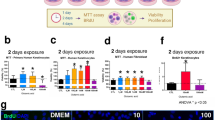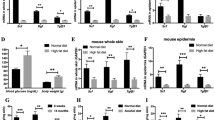Abstract
Proliferating cells, compared with quiescent cells, are more dependent on glucose for their growth. Although glucose transport in keratinocytes is mediated largely by the Glut1 facilitative transporter, we found that keratinocyte-specific ablation of Glut1 did not compromise mouse skin development and homeostasis. Ex vivo metabolic profiling revealed altered sphingolipid, hexose, amino acid, and nucleotide metabolism in Glut1-deficient keratinocytes, thus suggesting metabolic adaptation. However, cultured Glut1-deficient keratinocytes displayed metabolic and oxidative stress and impaired proliferation. Similarly, Glut1 deficiency impaired in vivo keratinocyte proliferation and migration within wounded or UV-damaged mouse skin. Notably, both genetic and pharmacological Glut1 inactivation decreased hyperplasia in mouse models of psoriasis-like disease. Topical application of a Glut1 inhibitor also decreased inflammation in these models. Glut1 inhibition decreased the expression of pathology-associated genes in human psoriatic skin organoids. Thus, Glut1 is selectively required for injury- and inflammation-associated keratinocyte proliferation, and its inhibition offers a novel treatment strategy for psoriasis.
This is a preview of subscription content, access via your institution
Access options
Access Nature and 54 other Nature Portfolio journals
Get Nature+, our best-value online-access subscription
$29.99 / 30 days
cancel any time
Subscribe to this journal
Receive 12 print issues and online access
$209.00 per year
only $17.42 per issue
Buy this article
- Purchase on Springer Link
- Instant access to full article PDF
Prices may be subject to local taxes which are calculated during checkout






Similar content being viewed by others
References
Vander Heiden, M. G., Cantley, L. C. & Thompson, C. B. Understanding the Warburg effect: the metabolic requirements of cell proliferation. Science 324, 1029–1033 (2009).
Palm, W. et al. The utilization of extracellular proteins as nutrients is suppressed by mTORC1. Cell 162, 259–270 (2015).
Comerford, S. A. et al. Acetate dependence of tumors. Cell 159, 1591–1602 (2014).
Hensley, C. T. et al. Metabolic heterogeneity in human lung tumors. Cell 164, 681–694 (2016).
Faubert, B. et al. Lactate metabolism in human lung tumors. Cell 171, 358–371.e359 (2017).
Hui, S. et al. Glucose feeds the TCA cycle via circulating lactate. Nature 551, 115–118 (2017).
Michalek, R. D. et al. Cutting edge: distinct glycolytic and lipid oxidative metabolic programs are essential for effector and regulatory CD4+ T cell subsets. J. Immunol. 186, 3299–3303 (2011).
Pearce, E. L. et al. Enhancing CD8 T-cell memory by modulating fatty acid metabolism. Nature 460, 103–107 (2009).
De Bock, K. et al. Role of PFKFB3-driven glycolysis in vessel sprouting. Cell 154, 651–663 (2013).
Schoors, S. et al. Fatty acid carbon is essential for dNTP synthesis in endothelial cells. Nature 520, 192–197 (2015).
Thorens, B. & Mueckler, M. Glucose transporters in the 21st Century. Am. J. Physiol. Endocrinol. Metab. 298, E141–E145 (2010).
Cura, A. J. & Carruthers, A. Role of monosaccharide transport proteins in carbohydrate assimilation, distribution, metabolism, and homeostasis. Compr. Physiol. 2, 863–914 (2012).
Gherzi, R. et al. “HepG2/erythroid/brain” type glucose transporter (GLUT1) is highly expressed in human epidermis: keratinocyte differentiation affects GLUT1 levels in reconstituted epidermis. J. Cell. Physiol. 150, 463–474 (1992).
Elson, D. A., Ryan, H. E., Snow, J. W., Johnson, R. & Arbeit, J. M. Coordinate up-regulation of hypoxia inducible factor (HIF)-1α and HIF-1 target genes during multi-stage epidermal carcinogenesis and wound healing. Cancer Res. 60, 6189–6195 (2000).
Tao, J. et al. Expression of GLUT-1 in psoriasis and the relationship between GLUT-1 upregulation induced by hypoxia and proliferation of keratinocyte growth. J. Dermatol. Sci. 51, 203–207 (2008).
Tochio, T., Tanaka, H. & Nakata, S. Glucose transporter member 1 is involved in UVB-induced epidermal hyperplasia by enhancing proliferation in epidermal keratinocytes. Int. J. Dermatol. 52, 300–308 (2013).
Watt, S. A. et al. Integrative mRNA profiling comparing cultured primary cells with clinical samples reveals PLK1 and C20orf20 as therapeutic targets in cutaneous squamous cell carcinoma. Oncogene 30, 4666–4677 (2011).
Young, C. D. et al. Modulation of glucose transporter 1 (GLUT1) expression levels alters mouse mammary tumor cell growth in vitro and in vivo. PLoS One 6, e23205 (2011).
Wellberg, E. A. et al. The glucose transporter GLUT1 is required for ErbB2-induced mammary tumorigenesis. Breast Cancer Res. 18, 131 (2016).
Macintyre, A. N. et al. The glucose transporter Glut1 is selectively essential for CD4 T cell activation and effector function. Cell Metab. 20, 61–72 (2014).
Liu, Y. et al. A small-molecule inhibitor of glucose transporter 1 downregulates glycolysis, induces cell-cycle arrest, and inhibits cancer cell growth in vitro and in vivo. Mol. Cancer Ther. 11, 1672–1682 (2012).
Kuehne, A. et al. Acute activation of oxidative pentose phosphate pathway as first-line response to oxidative stress in human skin cells. Mol. Cell 59, 359–371 (2015).
Zhang, Z. Z. et al. Glutathione depletion, pentose phosphate pathway activation, and hemolysis in erythrocytes protecting cancer cells from vitamin C-induced oxidative stress. J. Biol. Chem. 291, 22861–22867 (2016).
Schäfer, M. & Werner, S. Nrf2: a regulator of keratinocyte redox signaling. Free Radic. Biol. Med. 88, 243–252 (2015).
Amen, N. et al. Differentiation of epidermal keratinocytes is dependent on glucosylceramide:ceramide processing. Hum. Mol. Genet. 22, 4164–4179 (2013).
Jennemann, R. et al. Integrity and barrier function of the epidermis critically depend on glucosylceramide synthesis. J. Biol. Chem. 282, 3083–3094 (2007).
Takashima, A. & Bergstresser, P. R. Impact of UVB radiation on the epidermal cytokine network. Photochem. Photobiol. 63, 397–400 (1996).
Raja, S., Sivamani, K., Garcia, M. S. & Isseroff, R. R. Wound re-epithelialization: modulating keratinocyte migration in wound healing. Front. Biosci. 12, 2849–2868 (2007).
Hawkes, J. E., Gudjonsson, J. E. & Ward, N. L. The snowballing literature on imiquimod-induced skin inflammation in mice: a critical appraisal. J. Invest. Dermatol. 137, 546–549 (2017).
van der Fits, L. et al. Imiquimod-induced psoriasis-like skin inflammation in mice is mediated via the IL-23/IL-17 axis. J. Immunol. 182, 5836–5845 (2009).
Chan, J. R. et al. IL-23 stimulates epidermal hyperplasia via TNF and IL-20R2-dependent mechanisms with implications for psoriasis pathogenesis. J. Exp. Med. 203, 2577–2587 (2006).
Flutter, B. & Nestle, F. O. TLRs to cytokines: mechanistic insights from the imiquimod mouse model of psoriasis. Eur. J. Immunol. 43, 3138–3146 (2013).
Tortola, L. et al. Psoriasiform dermatitis is driven by IL-36-mediated DC-keratinocyte crosstalk. J. Clin. Invest. 122, 3965–3976 (2012).
Van Belle, A. B. et al. IL-22 is required for imiquimod-induced psoriasiform skin inflammation in mice. J. Immunol. 188, 462–469 (2012).
Sa, S. M. et al. The effects of IL-20 subfamily cytokines on reconstituted human epidermis suggest potential roles in cutaneous innate defense and pathogenic adaptive immunity in psoriasis. J. Immunol. 178, 2229–2240 (2007).
Fuchs, E. Scratching the surface of skin development. Nature 445, 834–842 (2007).
Freinkel, R. K. Metabolism of glucose-C-14 by human skin in vitro. J. Invest. Dermatol. 34, 37–42 (1960).
Sparks, J. W., Avery, G. B., Fletcher, A. B., Simmons, M. A. & Glinsmann, W. H. Parenteral galactose therapy in the glucose-intolerant premature infant. J. Pediatr. 100, 255–259 (1982).
Barone, S. et al. Slc2a5 (Glut5) is essential for the absorption of fructose in the intestine and generation of fructose-induced hypertension. J. Biol. Chem. 284, 5056–5066 (2009).
Zhao, F. Q. & Keating, A. F. Functional properties and genomics of glucose transporters. Curr. Genomics 8, 113–128 (2007).
Holden, H. M., Rayment, I. & Thoden, J. B. Structure and function of enzymes of the Leloir pathway for galactose metabolism. J. Biol. Chem. 278, 43885–43888 (2003).
Cantor, J. R. et al. Physiologic medium rewires cellular metabolism and reveals uric acid as an endogenous inhibitor of UMP synthase. Cell 169, 258–272.e217 (2017).
Hamanaka, R. B. et al. Mitochondrial reactive oxygen species promote epidermal differentiation and hair follicle development. Sci. Signal. 6, ra8 (2013).
Farber, S. & Diamond, L. K. Temporary remissions in acute leukemia in children produced by folic acid antagonist, 4-aminopteroyl-glutamic acid. N. Engl. J. Med. 238, 787–793 (1948).
Heidelberger, C. et al. Fluorinated pyrimidines, a new class of tumour-inhibitory compounds. Nature 179, 663–666 (1957).
Eugui, E. M., Almquist, S. J., Muller, C. D. & Allison, A. C. Lymphocyte-selective cytostatic and immunosuppressive effects of mycophenolic acid in vitro: role of deoxyguanosine nucleotide depletion. Scand. J. Immunol. 33, 161–173 (1991).
Greb, J. E. et al. Psoriasis. Nat. Rev. Dis. Primers 2, 16082 (2016).
Mehta, N. N. et al. Systemic and vascular inflammation in patients with moderate to severe psoriasis as measured by [18F]-fluorodeoxyglucose positron emission tomography-computed tomography (FDG-PET/CT): a pilot study. Arch. Dermatol. 147, 1031–1039 (2011).
Kamleh, M. A. et al. LC-MS metabolomics of psoriasis patients reveals disease severity-dependent increases in circulating amino acids that are ameliorated by anti-TNFα treatment. J. Proteome Res. 14, 557–566 (2015).
Kang, H. et al. Exploration of candidate biomarkers for human psoriasis based on gas chromatography-mass spectrometry serum metabolomics. Br. J. Dermatol. 176, 713–722 (2017).
Checa, A. et al. Circulating levels of sphingosine-1-phosphate are elevated in severe, but not mild psoriasis and are unresponsive to anti-TNF-α treatment. Sci. Rep. 5, 12017 (2015).
Lee, E. E. et al. A protein kinase C phosphorylation motif in GLUT1 affects glucose transport and is mutated in GLUT1 deficiency syndrome. Mol. Cell 58, 845–853 (2015).
Telang, S. et al. Small molecule inhibition of 6-phosphofructo-2-kinase suppresses t cell activation. J. Transl. Med. 10, 95 (2012).
Koo, S. W., Hirakawa, S., Fujii, S., Kawasumi, M. & Nghiem, P. Protection from photodamage by topical application of caffeine after ultraviolet irradiation. Br. J. Dermatol. 156, 957–964 (2007).
Wang, X., Ge, J., Tredget, E. E. & Wu, Y. The mouse excisional wound splinting model, including applications for stem cell transplantation. Nat. Protoc. 8, 302–309 (2013).
Lichti, U., Anders, J. & Yuspa, S. H. Isolation and short-term culture of primary keratinocytes, hair follicle populations and dermal cells from newborn mice and keratinocytes from adult mice for in vitro analysis and for grafting to immunodeficient mice. Nat. Protoc. 3, 799–810 (2008).
Holland, W. L. et al. An FGF21-adiponectin-ceramide axis controls energy expenditure and insulin action in mice. Cell Metab. 17, 790–797 (2013).
Carles, J. Colorimetric microdetermination of phosphorus. Bull. Soc. Chim. Biol. (Paris) 38, 255–257 (1956).
Mullen, A. R. et al. Oxidation of alpha-ketoglutarate is required for reductive carboxylation in cancer cells with mitochondrial defects. Cell Rep. 7, 1679–1690 (2014).
Acknowledgements
We thank the R. Gordillo for help with lipidomic studies; C. Yang, J. Sudderth, L. Zacharias, and J. Galvan Resendiz and the Children’s Research Institute Metabolomics Facility for help with metabolomic studies; L.-C. Tseng for help with patient sample collection; and P. Gerami for help with psoriasis models. This work was supported by the following grants: NCI R35 CA220449-01 and the Welch Foundation (I-1733-06) to R.J.D.; NIAMS K23AR061441 to B.F.C.; NIDDK DK10550 to J.C.R.; and NIAMS 1R01AR072655, Burroughs Wellcome Fund CAMS (1010978), and American Cancer Society/Simmons Cancer Center (ACS-IRG-02-196) to R.C.W.
Author information
Authors and Affiliations
Contributions
Z. Zhang, R.J.D., and R.C.W. designed the experiments. Z. Zhang, E.E.L., J.Z., M.M., and R.C.W. performed experiments. E.D.A. provided Glut1fl/fl mice. A.P.S. provided SCCT8 squamous cell carcinoma cells. B.F.C. enrolled patients. Z. Zhang, Z. Zi, E.E.L., J.Z., D.C.C., M.M., G.A.H., T.V., J.C.R., P.E.S., R.J.D., and R.C.W. analyzed data; R.C.W. and Z. Zhang wrote the manuscript, to which all authors contributed.
Corresponding author
Ethics declarations
Competing interests
The authors declare no competing interests.
Additional information
Publisher’s note: Springer Nature remains neutral with regard to jurisdictional claims in published maps and institutional affiliations.
Supplementary information
Supplementary Text and Figures
Supplementary Figures 1–11 and Supplementary Table 1
Supplementary Dataset 1
Lipidomics
Supplementary Dataset 2
Combined metabolomics
Supplementary Video 1
WT keratinocyte scratch assay video
Supplementary Video 2
K14.Glut1 keratinocyte scratch assay video
Rights and permissions
About this article
Cite this article
Zhang, Z., Zi, Z., Lee, E.E. et al. Differential glucose requirement in skin homeostasis and injury identifies a therapeutic target for psoriasis. Nat Med 24, 617–627 (2018). https://doi.org/10.1038/s41591-018-0003-0
Received:
Accepted:
Published:
Issue Date:
DOI: https://doi.org/10.1038/s41591-018-0003-0
This article is cited by
-
Nrf2 activation: a key mechanism in stem cell exosomes-mediated therapies
Cellular & Molecular Biology Letters (2024)
-
Metabolic rewiring of macrophages by epidermal-derived lactate promotes sterile inflammation in the murine skin
The EMBO Journal (2024)
-
Bioengineered skin organoids: from development to applications
Military Medical Research (2023)
-
Signaling pathways and targeted therapies for psoriasis
Signal Transduction and Targeted Therapy (2023)
-
Advances in the pathogenesis of psoriasis: from keratinocyte perspective
Cell Death & Disease (2022)



